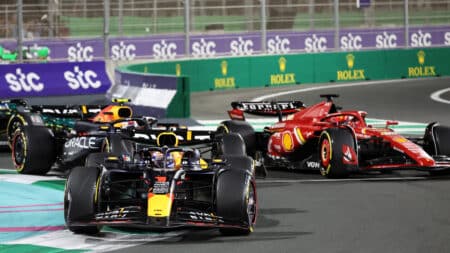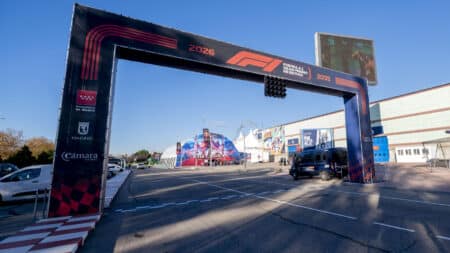
Which Red Bull will show up in Jeddah? - What to watch for at Saudi GP
Can Red Bull rebound from its poor Bahrain showing? And will it be Piastri or Norris leading McLaren's charge? Here's the five themes to watch for at the Saudi Arabian GP
The Iron Curtain was just beginning to twitch when the mechanised might of Formula 1 first rolled into Budapest town.
Well, not quite ‘town’ – rather a few clicks northeast.
The city had, however, been considered as a possible venue: in Népliget Park.
Fifty years before, in June 1936, this 270-acre splash of green in the capital’s southeastern suburbs had hosted the first Hungarian Grand Prix. Its 3.1-mile track was tight and twisty and so provided Alfa Romeo’s Tazio Nuvolari with another chance to blunt the Silver Arrows.
He took it.
Auto Union’s wunderkind Bernd Rosemeyer and Mercedes-Benz old hand Rudolf Caracciola enjoyed turns in the lead, but Nuvolari gradually increased the pressure in his underpowered but nimble 8C-35 and broke the Germans.
The usually irrepressible Rosemeyer had to be lifted from the cockpit after finishing second, his hands blooded and blistered. The subsequent hospital visit, however, concerned the lingering liverish effects of a poisoned oyster. His sudden and drastic collapse – he shed 37 seconds to Nuvolari in fewer than 10 miles – was a rare display of weakness in an otherwise glittering season.
Races scheduled for 1937 and ’38 were cancelled and all momentum was lost courtesy of the combined megalomania of Hitler and Stalin. By the Thatcherite 1980s, however, “the happiest barrack” on the Bloc was ready to dip its toe into the capitalist Piranha Pool of F1.
Bernie Ecclestone, perspicaciously keen to head east, reportedly liked what he saw at Népliget Park. Local conservationists – ah, those touchy-feely Warsaw Pact tree-huggers – did not like what they heard and blocked the plan.
It was easier to build afresh. To prove the point a Stakhanovite stint saw the Hungaroring rise from its dustbowl in only eight months. It’s been a GP ever-present ever since, the apparently uninspiring track growing on us over time and providing many memorable moments:
Nigel Mansell’s opportunistic jinking pass of Ayrton Senna in 1989 and world title-clinching drive of 1992 (above); Damon Hill’s maiden victory of the following year and agonising near miss with (another silver) Arrows in 1997; and Michael Schumacher’s strategic masterclass of 1998 and Fernando Alonso’s first win in 2003.
Plus four wins for Lewis Hamilton since 2007.
Yet Hungary has registered a big fat (with apologies to) Zsolt in the GP driver stakes. Which is ironic given that an Austro-Hungarian won the first national race to boast the GP nomenclature.
Ferenc Szisz – or more correctly Szisz Ferenc – was born in Szeghalom, then part of the Hapsburg Empire, on 20 September 1873, the sixth of seven children.
After training as a locksmith and coppersmith, his engineering bent and ambition saw him gravitate, via spells in Vienna and Berlin, to Paris, then at the centre of the burgeoning automobile industry.
He joined nascent Renault and swiftly became its test and development driver. His first motorsport experience, however, was as the riding mechanic to Louis Renault on the 1902 Paris-Vienna Trial.
When the latter’s brother Marcel was killed in the cataclysmic 1903 Paris-Madrid race, Louis halted the company’s motor sporting activities.
It soon became clear, however, that this was unrealistic as dozens of competing firms fought for a sustainable market share, and Szisz, pronounced ‘Sis’, led Renault’s return in 1905. He showed promise in the Gordon Bennett Elimination Trial, held in the Auvergne, and Long Island’s Vanderbilt Cup before finishing fifth in both after spates of niggling delays.
In June 1906, he led the team’s three-car entry for the inaugural Grand Prix de l’ACF at Le Mans. He took the lead of this two-day event on its third 64-mile lap and held it to the end.
Undoubtedly he was helped in his quest by Michelin’s new detachable rims, but he wasn’t alone in using them and still had to change 19 punctures over the 769 miles.
His speed and consistency allowed him to open a margin sufficient to be able to nurse a broken rear suspension for the final two laps and still win by more than half an hour.
He was, of course, now known as François Szisz.
2013 Lewis Hamilton, Mercedes
2012 Lewis Hamilton, McLaren-Mercedes
2011 Jenson Button, McLaren-Mercedes
2010 Mark Webber, Red Bull-Renault
2009 Lewis Hamilton, McLaren-Mercedes
2008 Heikki Kovalainen, McLaren-Mercedes
2007 Lewis Hamilton, McLaren-Mercedes
2006 Jenson Button, Honda
2005 Kimi Räikkönen, McLaren-Mercedes
2004 Michael Schumacher, Ferrari
2003 Fernando Alonso, Renault
2002 Rubens Barrichello, Ferrari
2001 Michael Schumacher, Ferrari
2000 Mika Häkkinen, McLaren-Mercedes
1999 Mika Häkkinen, McLaren-Mercedes
1998 Michael Schumacher, Ferrari
1997 Jacques Villeneuve, Williams-Renault
1996 Jacques Villeneuve, Williams-Renault
1995 Damon Hill, Williams-Renault
1994 Michael Schumacher, Benetton-Ford
1993 Damon Hill, Williams-Renault
1992 Ayrton Senna, McLaren-Honda
1991 Ayrton Senna, McLaren-Honda
1990 Thierry Boutsen, Williams-Renault
1989 Nigel Mansell, Ferrari
1988 Ayrton Senna, McLaren-Honda
1987 Nelson Piquet, Williams-Honda
1986 Nelson Piquet, Williams-Honda
1985-1937 No race
1936 Tazio Nuvolari, Alfa Romeo, (Népliget)
The following year in Dieppe he was perhaps too cautious in the advent of a fuel consumption formula – 30 litres per 100 kilometres – and lost out to his great FIAT rival Felice Nazzaro.
At the same circuit in 1908, he was third after the first lap but was an early retirement with a broken rim. He retired, too, from that year’s inaugural American Grand Prize in Savannah, Georgia, because of a failed wheel bearing.
He left Renault in 1909 to open a garage in Neuilly-sur-Seine.
Persuaded to return to the sport by turn-of-the-century star Fernand Charron, he drove an Alda in the 1914 French GP at Lyon. Szisz started at one but swiftly tumbled to the tail of the field because of a radiator change.
His disappointing day ended dramatically when another car struck and broke his arm as he was changing a puncture by the roadside.
Despite this injury he would a few weeks later win a minor sports car race in a Lorraine-Dietrich.
And that, bar an unwise outing at the wheel of a streamlined La Buire saloon in a support race at the 1924 French GP at Lyon, was that.
Pretty much for Hungary as well as Szisz.
USA resident Steve Nemesh started but didn’t finish the 1926 Indy 500.
Wealthy Láslzo Hartmann didn’t impress his driving instructor yet met with mild success in Bugattis and Maseratis during the 1930s before fatally touching wheels with ‘Nino’ Farina at the 1938 Tripoli GP.
Csaba Kesjár drove an F1 Zakspeed for three demo laps after the 1987 Hungarian GP but sadly was killed the following year in a Norisring F3 race.
Norbert Michelisz has scored three victories in the WTCC, including an emotional success at the Hungaroring in 2012.
And 23-year-old Támas Pál Kiss has registered wins in British Formula Renault and GP3, and currently lies second in the Auto GP World Series.

Gianmaria Bruni, Paul Stoddart and Zsolt Baumgartner at the launch of the Minardi PS04B
But Zsolt Baumgartner’s dogged eighth place – credit where credit is due – with Minardi in the 2004 United States GP remain the only points scored by a Hungarian at the sport’s highest level.
Of course, it’s not just about drivers.
János Viktor – or should that be Viktor János? – was born to Hungarian immigrants in Piedmont in 1891. You will likely know him as Vittorio Jano, legendary designer of, among many others, Nuvolari’s nimble 8C-35.

Can Red Bull rebound from its poor Bahrain showing? And will it be Piastri or Norris leading McLaren's charge? Here's the five themes to watch for at the Saudi Arabian GP

McLaren's breakthrough in a near-four-year-old ruleset shows F1 rules convergence is a myth – just like Sebastian Vettel, Red Bull and Renault did in 2013, writes Mark Hughes

Madrid finally has a consortium to build the new Formula 1 circuit that will host the 2026 Spanish GP

Helmut Marko caused a stir after the Bahrain GP with his worries that Max Verstappen could leave Red Bull early. But how real are those fears?